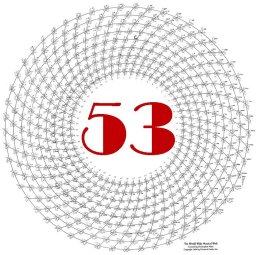Microtonal voicing
Comma masking through voice movement
- A chord with C – G1 in it sounds way off (that’s the dreaded “wolf” interval), but a melodic leap from C – G1 may be less obvious. Notes stacked on top of one another should always sound good together. They say time heals all wounds, and moving a comma through time is much easier on the ear.
- A good place to hide commas or move through a chord progression with an embedded comma is in a diminished seventh chord, which sounds a bit weird to the ear anyway.
- If the A1 – A comma is being performed by a singer or string player, the musician can easily do an extremely subtle glissando from the A1 to the A, wherever it appears in the voicing. In my composition, “From This Kind of Longing,” the vocalist is asked to sing the two notes of a comma as discreet pitches to emphasize the comma shift.
- C to C2# (a ga-ga ½ step) is about the smallest half step that can be voiced in standard ways. Maybe 1/4 tone needs traditional voicing rules. Really watch out for aug 2nd, tritone and other weird leaps. Many are almost unsingable. Single-comma movement is OK anywhere. Double comma movement like the Great Diesis is OK only in middle lines unless you want to really highlight it. To mask it when it appears in the bass or soprano lines, use a passing tone between the two notes (such as C – D – C2), or some kind of trill, vibrato or other ornamentation.
- Commas generally are least noticeable when hidden in the middle voices.
- Didymic commas and Disachismas are small enough that they can still sound OK in upper voices, but they vanish almost entirely when sounded in the inner voices.
These are just a few of the tentative voicing rules I have come up with when dealing with microtonal intervals. There are many more in this chapter, and time and practice will no doubt bring us more rules and traditions to make microtonal voicing sound smooth and natural. If you would like to learn more about this chapter, “Microtonal Voicing,” you can buy the entire book, The Grand Unified Theory of Music, in pdf form for $25 with hundreds of embedded musical examples of scales and chords from all over the world.
A free introduction to what The Grand Unified Theory of Music offers is on this website and includes both text and a few musical examples from each webpage. If you would like to learn more about this chapter and the full contents of this entire e-book, you can buy The Grand Unified Theory of Music for $25, with hundreds of embedded musical examples of scales and chords from all over the world — and ideas for how to set up your computer system —
HERE.
You’ll get a personalized password you can use to see the entire e-book. Inside the full book, you will also get a link to the complete pdf file of this e-book, which you can read on your Kindle or similar device. The links to the hundreds of mp3 sound files – the same ones you can hear on the website — will also be included. This is “Version 1.0” of The Grand Unified Theory of Music. Because it is an e-book, additions, corrections and improvements in the sound may be added at any time. The Grand Unified Theory of Music is Copyright © 2018 by Christopher Mohr. All rights reserved.
One person per password. Sharing this password with others is a violation of copyright. Do not allow others to use your password or link to the pdf file!
